 Part Three – The German Training Scale – illustration by Andie O’Meara
Part Three – The German Training Scale – illustration by Andie O’Meara
The Objective
Do you know the German scale of training? Sure, you’ll say: ‘Rhythm, looseness, contact, aaaand…. forwardness, straightness and collection. Right?’
Right, but there is a big difference between knowing the words and true understanding. It is similar to being in school: knowing the vocabulary and speaking a foreign language aren’t the same. Those who want to move from knowing, to being able to do it, have to dig deeper. The scale of training is the fundamental tool for the trainer of young horses.
In our third and last part of the series Schooling of the young horse with Susanne Miesner, Pferdewirtschaftsmeister (Master of Horse Management) and author of several equestrian books, we deal with preparing the youngster for dressage. We look at lessons that are important for a well-rounded basic education. Needless to say there is not the one-and-only thing a young horse needs to learn. Variety such as riding across country and little jumps need to complement the schooling.
As described in Part Two, the first months were devoted to letting the young horse get used to the rider’s weight. The horse mainly had to learn to balance itself. Furthermore it needed to accept forward driving aids, go towards the bit, react to soft stopping aids and be prepared to stretch forward at all times. The most important things are rhythm and looseness. The contact should be soft and elastic and most importantly, the line of forehead and nose must be in front of the vertical. This will remain the same when we have reached the first objective and can start to raise the standard during our periods of work.
These three main points, rhythm, looseness and contact remain the foundation for progress in every stage of future schooling. Never be without it – looseness is vital.
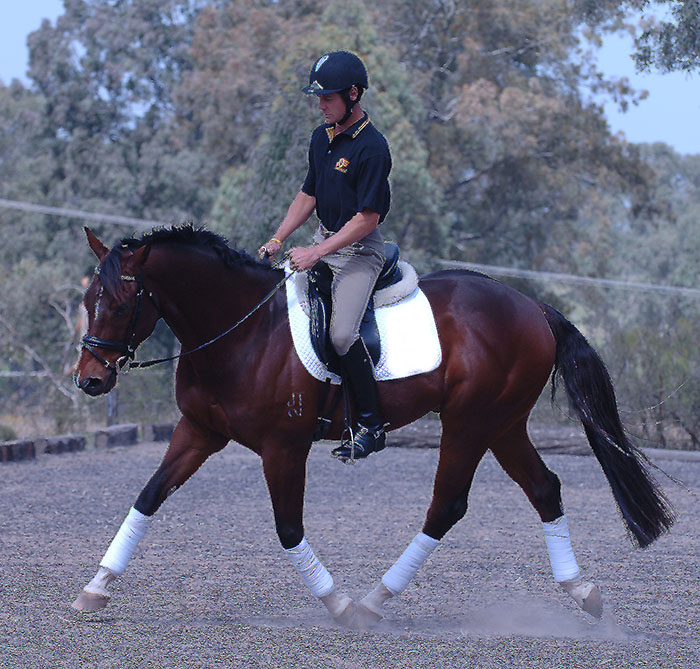
‘That’s just the theory.’ Very often you can hear that statement whenever the scale of training is mentioned. For a test or an exam you may learn the terms, but are they really important? They are hard to understand, that’s for sure. Rhythm might be the easiest. And everybody knows that mistakes in rhythm are connected to a lack of looseness. But what exactly is meant by looseness and why is it necessary?
To get to the answer we should reverse the question, what isn’t looseness?
Looseness does not mean being loose in terms of weak or tired. The muscles need to be loose, but looseness in the equestrian sense does include a certain degree of contraction of the muscles. Nevertheless it does not include clenching or rigidity. Looseness means a positive contraction and release. Think back to the example of the dancers.
How do we imagine a good dancer? Not the shuffler who hardly gets his feet off the ground, or the repressed youngster who stiffly directs his lady from two metres away, or the rigid body builder who confuses the dance floor with the gym.
We imagine the dancer in a straight upright position with movements that are smooth flowing and positive. Translated to the horse it means: the loose horse that moves smoothly but dynamically, with noticeably contracting and relaxing muscles. A horse that is tight or hardly gets the hind legs out of the sand is lacking looseness just like the one that hurries away from under the rider’s weight. Blocking and rushing are always indications of a lack of looseness.
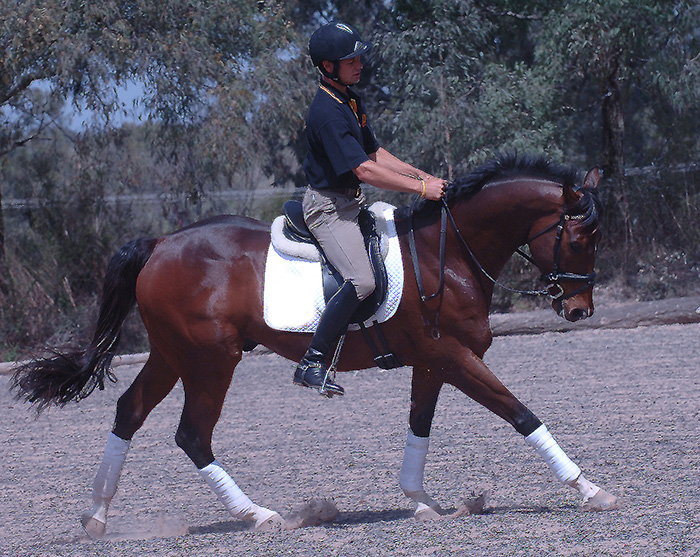
The rider needs to understand and be able to feel that this ‘outer’ looseness can only be achieved in combination with an ‘inner’ looseness, meaning that the horse is relaxed, feels well and trusts the rider. Without inner looseness you never achieve outer looseness. The horse can only achieve real looseness if the rider’s seat and his or her looseness enables it to do so.

The back is the centre of every move:
Rhythm and looseness are not just for their own sake, but are the foundation for riding being enjoyable for the rider and for the horse. Let’s look at the horse and its anatomy. The engine is located in the hind legs, the back is the centre point that directs every move through the whole horse. If this centre is malfunctioning because the back muscles are still not loose, we will encounter different problems. Depending on the individual horse it could be problems with rhythm, mouth and tongue, resistance through the neck, leaning on the bit, withdrawing behind the bit, unruliness, nervousness, laziness or rushing. Many problems stem from lack of looseness and unsatisfactory movement of the back and most can be resolved there.
next Susanne talks about the importance of back movement
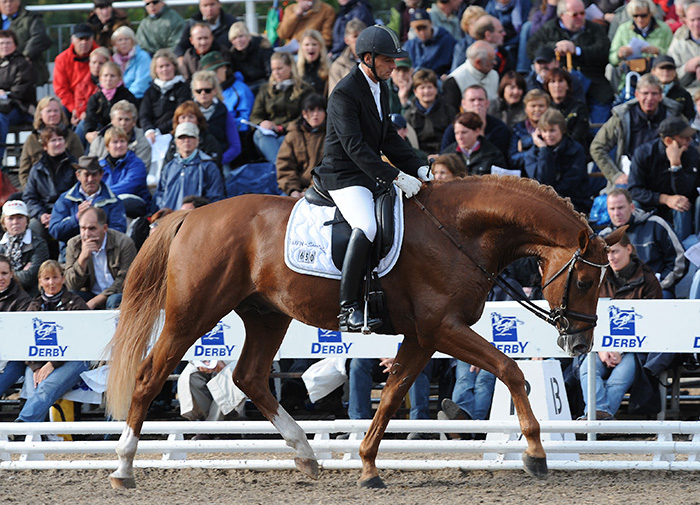
Today, more often than in previous times, a mistake concerning the movement of the back is noticeable in basic education. The back muscle of the horse can only work correctly and take the rider comfortably in motion if the horse can balance itself. For that it needs its neck. The young horse needs to stretch the neck forward and downward in order to bring the back up. If the horse, especially a young one, is made too tight in the neck or brought up into the hand too early, it will tighten the back muscle which doesn’t allow the movement or the aids of the rider to flow through. It is not hard to tell which state is more agreeable for both partners.
Therefore again: looseness is based on a rhythmically moving horse and the contact resulting from it, which is felt comfortably in the rider’s hand. This is the foundation of every schooling session. This what we are working on improving.
Even as the schooling progresses the rider needs to continue to work at this. Especially at the end of the warm up phase and at the end of the working phase, letting the rein slip through your hands will show whether your work has been successful.
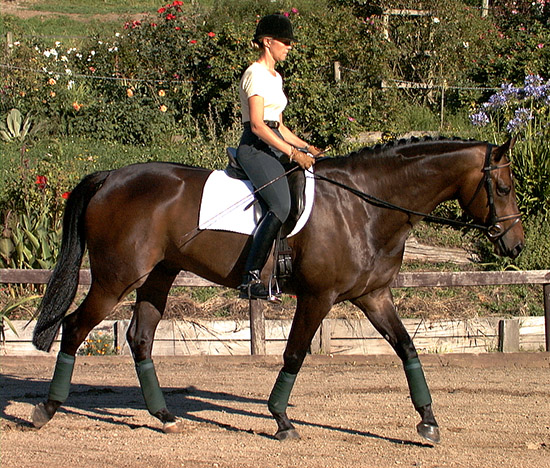 Transitions free up energy
Transitions free up energy
With progressive schooling, transitions should be refined. The correct use of half halts is vital. The rider should realize that half halts don’t mean pulling on the reins. Half halts are not only aids of the rein, but a combination of all aids. Only then does it become clear that a well-ridden half halt is not a trained movement, but has to do with the balance of the horse.
The competent rider uses the right timing to drive the hind legs with his aids more forward under the horse’s centre of gravity. And he will slow down the drive forward with softly restraining aids. In a well executed half halt the horse will pick up the restraining aid.
If transitions are ridden like that, the movement can flow through the horse. Especially at transitions within a pace, rhythm, looseness and with it the function of the back can be improved. The horse starts to exhibit more drive with the hind legs and begins to develop more impulsion – point four on the scale of training. If the neck is positioned correctly the back muscles will get stronger and the movement returns to its natural quality. It is important to realize that this is still not medium trot, or medium canter, but just longer steps or strides. The extended tempi will be developed from these. Transitions between the paces like trot-canter and trot-walk will improve the flow through and can, if only for short moments, ask the hind legs to carry more weight.. With a loose horse and a skilled rider this seldom causes problems. It will get difficult, though, if the aid comes at the wrong moment or is too strong or too weak.
By now sitting trot is ridden more often during the working phase. However, there is nothing wrong with rising trot and letting the rein slip through your hand after a well executed manoeuvre. Sometimes it can be valuable to start rising trot again after you have encountered resistance, especially if the resistance stems from tight back muscles. Force can not achieve much against a tight back.
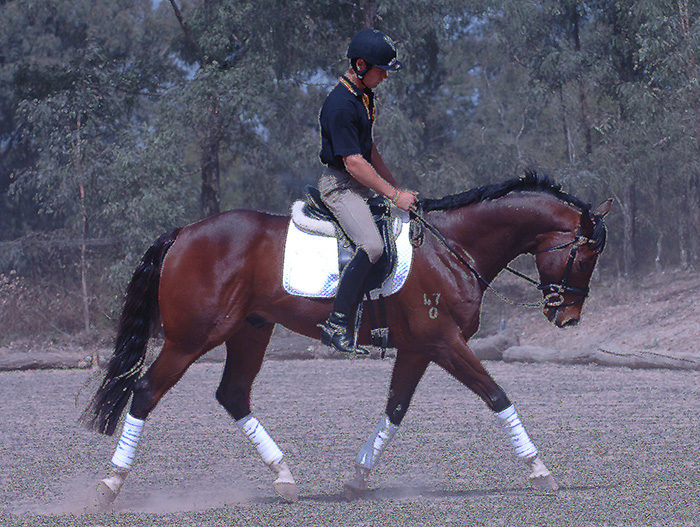
Sounds weird: flexing and bending to straighten
When the horse can be framed by the rider’s aids, the forward sideways driving leg can be used more. Lessons like making the circle smaller (on one track) and moving out again by a driving leg, trotting over on the open side of the circle or minimizing and traversing improve the working of the back and make the horse more elastic along the ribcage. With improved schooling, flexing and bending are begun and improved. By riding on curves the horse becomes softer on both sides. Larger turns ridden in rhythm, and with impulsion, are more valuable than too small turns begun too early. It is not the size of the turn, but the quality that is important. Correct flexing and bending accordingly can only be asked from a horse if the contact is correct.
To solve problems with flexing and bending which appear during schooling, the rider needs to be able to recognise the natural bend of the horse, and has to be able to differentiate between the hollow and the stretched side of their horse.
When riding on the stretched side, the rider often tries to correct problems by leaning on the rein or by pulling. Every experienced trainer knows that this just achieves the opposite. Only if both hind legs are on track, meaning come forward under the centre of gravity, is the horse able to bend willingly to both sides.
This even schooling of both sides of the body is the main objective of basic training and it is the foundation for collection, the sixth and last step on our scale of training. If the basics are right, i.e. the horse is loose and not under pressure with a tight back you can begin to work at collection even in the second year of schooling – but for short intervals. It is the same here: we aim for small steps that we build on.
Everything is right if the basics are right
Good basic training means the horse will be willingly and loosely following the rider’s aids. It means that the horse carries the rider’s weight evenly and without suffering damage and that it enjoys being under saddle. If you have done that you have achieved a lot and given joy to yourself and your horse.
If the basic criteria of the scale of schooling are tested and improved regularly, your will continue to progress during the second year of training. You can move on to tight turns like volte (6 metre circles) and serpentines, transitions from walk to canter, and later from canter to walk, halts, backing etc. Towards the end of the second year and with more schooling we can start to work at Elementary level.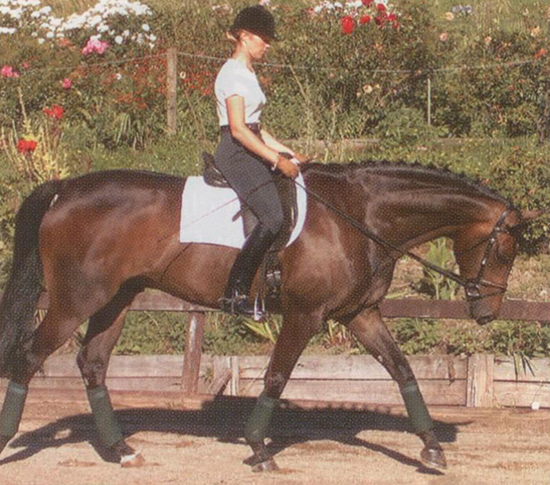
Test yourself – Objectives achieved?
If you can answer yes to most questions you have met many objectives of basic training. Ideally this will take around two years.
• Your horse moves in rhythm in all three gaits?
• After warming up at a walk with a slack rein you can get your horse accepting the bit without problems. The line of forehead and nose will stay in front of the vertical?
• At the end of the warm up phase your horse will swing through the back , moves towards the bit and is prepared to stretch forward and downward towards your hand?
• The contact is constant?
• During the working phase you can work at transitions without resistance or tightness?
• Your horse lets you sit comfortably and takes you with him?
• Turns are executed safely and in balance?
• You can flex and bend your horse to both sides. It comes into the outer rein?
• Your horse accepts the leg forward/sideways?
• The horse goes alone or in a group? The horse is quiet and relaxed when riding out?
• The horse is familiar with poles, cavaletti and jumps with the rider and stays calm and relaxed?
This article first appeared in the March 2004 issue of THM.



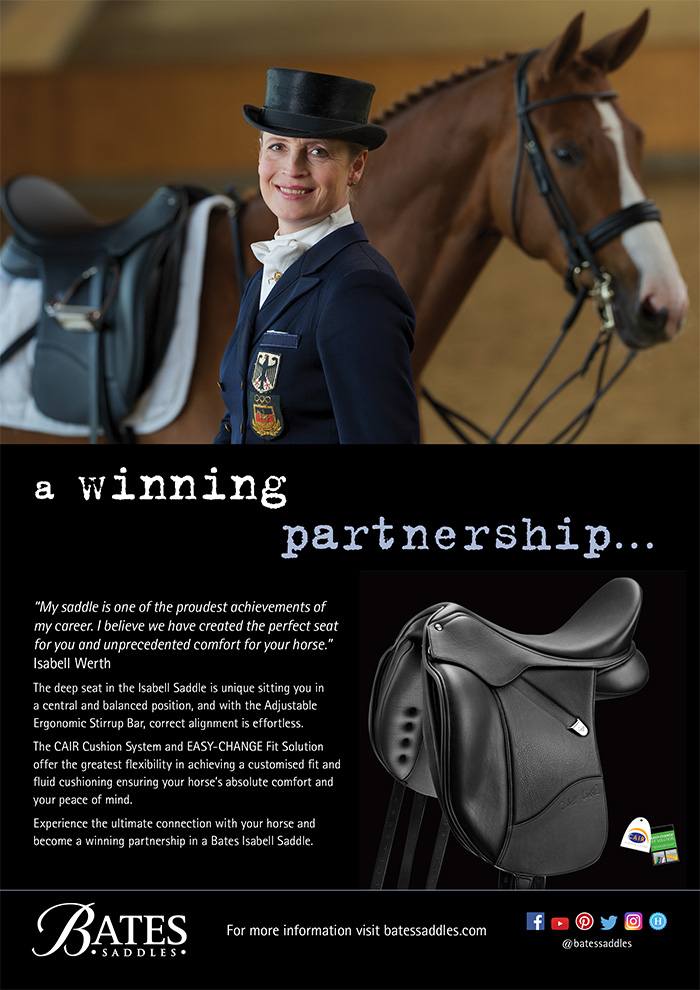
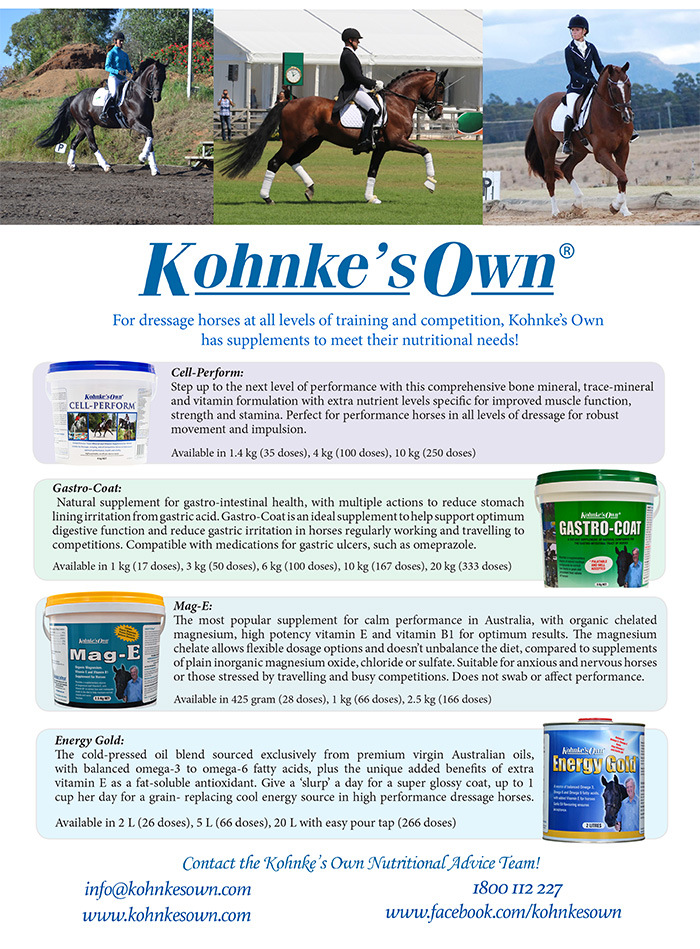
So wonderful to hear the theory put this way , easy for the rider to understand and imperative for the horse